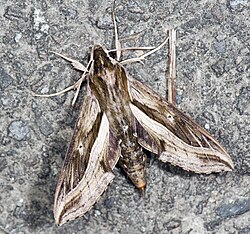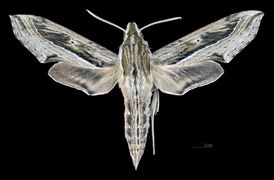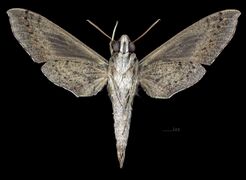Biology:Hippotion velox
| Dark striated hawkmoth | |
|---|---|

| |
| Scientific classification | |
| Domain: | Eukaryota |
| Kingdom: | Animalia |
| Phylum: | Arthropoda |
| Class: | Insecta |
| Order: | Lepidoptera |
| Family: | Sphingidae |
| Genus: | Hippotion |
| Species: | H. velox
|
| Binomial name | |
| Hippotion velox (Fabricius, 1793)[1]
| |
| Synonyms | |
| |
Hippotion velox, the dark striated hawkmoth, is a species of sphingid moth or the family Sphingidae. The species was described by Johan Christian Fabricius in 1793.
Distribution
It is found throughout the Indo-Australian tropics of India , Sri Lanka and east to Fiji and New Caledonia, north to Hong Kong, Taiwan, Sumatra southern Japan and northern Australia from Western Australia to Queensland.[2]
Description
The wingspan is 54–76 mm. The head and thorax are brown with pale lateral streaks. The abdomen is brown with numerous dark strigae and pairs of pale lateral striage on each segment. The forewings are brown without any silvery makings, thus differ from T. celerio. Hindwings are smoky brown with traces of a darker submarginal line.[3]
The final instar occurs in two forms, green and dark.[4] Larvae are pale green or brown with dorsal black dots. There is an eyespot on the 4th somite which is blue centered with yellow in the green form. An ochreous black ring is present in brown form. There is a subdorsal line from 5th to 11th somite. Horn is purplish in the green form. Pupa is bone colored, closely spotted and speckled with brown and some black dots.
The larvae have been recorded on Araceae, Convolvulaceae, Nyctaginaceae and Rubiaceae species, including Ipomoea, Boerhavia and Morinda species.[5]
References
- ↑ "CATE Creating a Taxonomic eScience - Sphingidae". Cate-sphingidae.org. Archived from the original on 2012-10-20. https://web.archive.org/web/20121020075438/http://www.cate-sphingidae.org/taxonomy/Hippotion/velox.html. Retrieved 2011-10-25.
- ↑ "Hippotion velox". Butterfly House. http://lepidoptera.butterflyhouse.com.au/sphi/velox.html. Retrieved 5 July 2016.
- ↑ Hampson, G. F. (1892). The Fauna of British India, Including Ceylon and Burma: Moths Volume I. Taylor and Francis. https://www.biodiversitylibrary.org/item/180068#page/5/mode/1up.
- ↑ "Hippotion velox Fabricius". http://www.mothsofborneo.com/part-3/sphingidae/sphingidae_29_1.php. Retrieved 5 July 2016.
- ↑ Pittaway, A. R.; Kitching, I. J. (2018). "Hippotion velox (Fabricius, 1793) -- Dark striated hawkmoth". http://tpittaway.tripod.com/china/h_vel.htm. Retrieved December 15, 2018.
- Pinhey, E. (1962). Hawk Moths of Central and Southern Africa. Longmans Southern Africa, Cape Town.
- Barnett, L. K.; Emms, C. W.; Holloway, J. D. (July 1, 1999). "The moths of the Chagos Archipelago with notes on their biogeography". Journal of Natural History 33 (7): 1021–1038. doi:10.1080/002229399300065.
Wikidata ☰ Q590850 entry
 |





